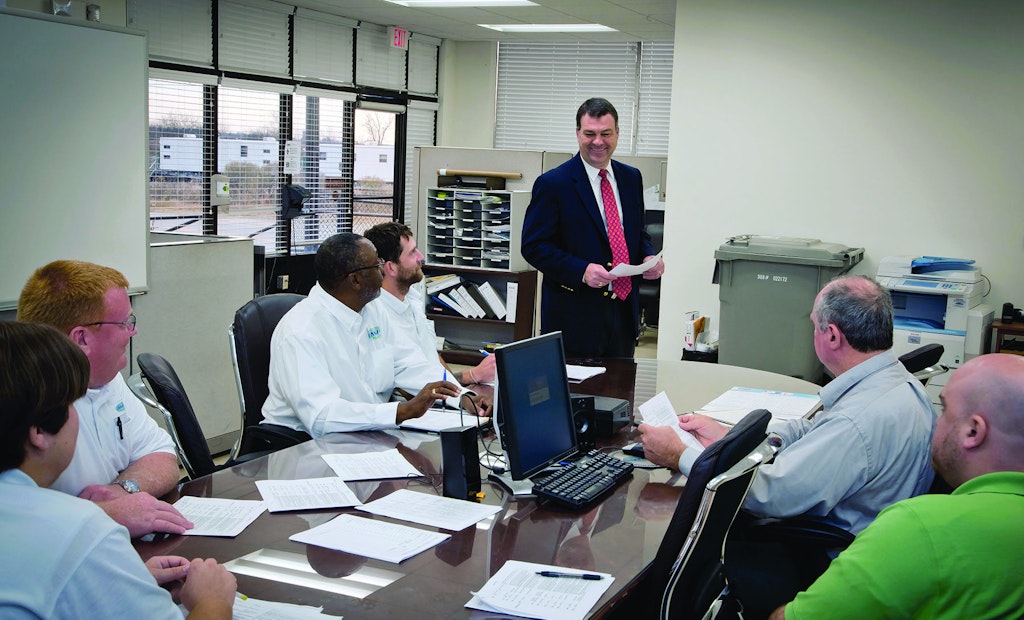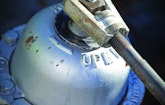
Interested in Cleaning?
Get Cleaning articles, news and videos right in your inbox! Sign up now.
Cleaning + Get AlertsAlmost seven years ago, the Macon Water Authority turned its handling of maintenance upside down, or as department personnel would probably consider a more accurate description, right side up.
Until then, maintenance employees for the authority, which handles both water purification and distribution and wastewater collection and treatment for the central City of Macon, Ga., were stationed at individual plants and facilities the MWA operates. They answered to the individual plant supervisors.
Repairs were generally limited to responding to immediate needs in every operation. The priorities were set by the individual plant supervisors without regard to what was most important for the whole system. Crisis management was the norm.
And because repair parts were stored elsewhere at an MWA warehouse, fixing problems often required extra time for workers to go get what they needed, then return to the plant to make the repair.
A new approach
Beginning in 2006, the authority took a long, hard look at its operations. The MWA brought all of its mechanics into a centralized maintenance department under a single maintenance manager. “It has paid off in efficiency,” says Ray Shell, assistant executive director at the MWA.
But that’s just part of the story at MWA.
“It was all part of a larger effort for us to improve the management and maintenance of our asset,” says MWA Executive Director Tony Rojas. “It probably took us as much as five years from beginning to end, but we were very methodical about our actions.”
Today, the authority manages those maintenance tasks with extensive high-tech help: a computerized maintenance management system and software that keeps track of the location and condition of every pump, pipe and valve in both the water and the sewer system. But perhaps most important is the MWA’s proactive approach — one that extends beyond maintenance to include conservation of the natural resource that many of its customers take for granted: the community’s water supply.
It wasn’t necessarily cheap; Macon spent a lot up front over the years to make the needed changes, Rojas says. But Rojas and Shell have no doubt that it was worth it, and that it will pay back in the long run by holding down operating costs, extending the life of the authority’s infrastructure, and preserving the community’s resources for a long time to come.
Musical birthplace
Macon is perhaps best known as a seedbed for American popular music. R&B stylist Otis Redding, rock pioneer Little Richard, and seminal southern rockers The Allman Brothers Band all hailed from the community, as did the founders of Capricorn Records, the Allmans’ label.
With a population of about 92,000 in the city and 160,000 in the broader metro area, Macon’s demand for water is fairly typical of a community its size, Rojas says. The biggest water and sewer customers include a couple of large industries. There’s a zipper factory owned by the international company YKK, which uses water for electroplating all those zippers. And there’s also a mill operated by Graphic Packaging International, a maker of boxes and other paper-based packaging products.
Water bills go to a total of 52,000 accounts. The sewer customer base is smaller, with 41,000 accounts. The authority also sells wholesale water to adjacent Monroe County.
The authority’s water supply comes originally from the Ocmulgee River, which feeds the authority’s reservoir.
“We are about as far south as you can go in this part of the country and still have a surface water treatment plant,” says Shell. “Everybody uses groundwater south of here.”
The location has kept Macon free from the sort of territorial water-supply conflicts that many communities experience, Rojas says. And both the quality of the water supply and Macon’s state-of-the-art water treatment facilities helped the city earn the distinction of having the nation’s best-tasting water as judged by the American Water Works Association in 2009.
Turning points
There wasn’t one single turning point that sent Macon on the path of continual improvement it’s been traveling for many years now. But one important event dates back nearly 20 years, when Hurricane Alfredo flooded the authority’s water plant in 1994. “Macon was without drinking water for 21 days,” says Shell.
With federal help, the authority built a new water treatment plant. The facility was constructed on higher ground next to a 5.9-billion-gallon reservoir the authority built in 1994 to hold water collected from the Ocmulgee until it’s ready to be used. The new treatment plant went online in 2000.
The reservoir gives sediment in the water time to settle out, and the treatment plant uses chlorine dioxide and activated carbon filtration to help further purify the water before it goes to the customers’ faucets.
Having the reservoir “has really benefited us through these droughts we’ve seen,” Rojas says. “We haven’t suffered or had any problems in being able to supply water to our customers.”
The water authority hired Rojas, who was the city manager of another Georgia community at the time, as its executive director in 2002, and Shell as his deputy in 2005. Rojas and Shell say a lot of the credit for supporting the changes employees have made over the last decade goes to the late Frank Amerson Jr., a prominent member of the local construction industry who served on the authority’s elected governing board for 35 years, 27 years as chairman. He died in September 2012.
“[Amerson] understood and appreciated the value of water and sewer infrastructure,” Rojas says. “He worked with the board so they were able to get us the things we needed.”
The goal was to reorganize the authority staff so that it operated more like a business, and one that was attentive to the needs and convenience of the customer, Rojas says. “We had good employees,” he explains. “We just needed to give them direction and give them an opportunity to do business in a way that would allow them to succeed.”
It was that goal that led the authority to consolidate maintenance employees into their own department, with a maintenance supervisor directing their work across all of the authorities’ properties.
The change provided several advantages, Shell and Rojas say. For one thing, it made the best use of employees’ individual expertise. A talented pump repair person, for instance, could be dispatched to fix failing pumps anywhere in the system, not just at the plant where he was stationed under the old arrangement.
It also made it easier to begin focusing on preventive maintenance and prioritizing repairs instead of just responding to whatever local fire was burning at the moment.
The new organization has made it easier to keep more maintenance work in-house, although Macon still makes use of outside contractors, especially for highly specialized repairs.
Job titles changed as well. Macon created four positions of maintenance planner. The people in that job are coordinating the maintenance work — triaging based on how serious it is and working out the logistical details.
The authority also began using written work orders to help sort out the tasks to be completed, in contrast to the less formal approach of the past.
“How it was done before — you’d just know something’s broken and it needs to be fixed,” says Rojas. “You might have some idea of what it is, and the crew might drop by the warehouse and pick up a few things they think they need. Then when they get to the job and see what it is, they need this part and this part and this part …”
The maintenance planners aren’t supervisors, but they do set the priorities for the rest of the maintenance crew.
“They define the work, look at all the needs, and do all the shopping for supplies,” Shell explains. The maintenance planner establishes which materials are needed for a job, special tools that may be required, or even regulatory permits that the authority would have to take out in order to do the work.
The planners make rounds on the system checking out every item that needs repairs.
Then they assemble repair kits for the rest of the workers to use — and to make sure they have all the parts they need to do it right the first time.
“When the crew shows up in the morning and they’re assigned by the foreman to a particular work order, they go into the warehouse and get the kit. Inside the box is all that’s needed to do that job,” Shell says. “They go out to the job with one visit, and they start their work.”
Maintenance workers have also learned to exercise judgment. For instance, under the old arrangement, every lift station would get a visit each year — 52 in all.
Now the number of lift stations is up to 58, but they actually don’t need to be visited as often, thanks to the city’s SCADA monitoring systems, which keep an eye on the lift stations by remote control.
Put to the test
Another part of the revised approach was testing every valve and other moving part in the system — the dynamic assets. Using Computerized Maintenance Management System software, the authority assembled an inventory of all of its assets. The database is linked to the city’s GIS mapping system, and there are some 26,000 photos of system assets.
Even before that, though, “we redesigned our business processes,” says Rojas. “We looked at how we did everything.”
Up to that point, some individual facilities in the system used software and others didn’t. As part of the process redesign, everyone was put on the same software.
Now, weekly meetings among the plant operators are the starting point to assembling the weekly list of tasks. Although an emergency might push something to the top of the pile, generally the maintenance crews have their work planned out for the week ahead.
Supervisors had to adjust to the idea of not declaring every repair an “emergency,” Shell and Rojas acknowledge. But they’ve learned. “They’ve developed a level of respect for that emergency list that they don’t violate,” Shell says.
Maintenance budgets remain the responsibility of the treatment plant supervisors.
Getting used to it
Rojas says that being more efficient saves money in the long run. So does making repairs promptly before a defect becomes more costly to fix.
That doesn’t mean spending less on maintenance overall, however. “We’ve actually spent a good bit more money on maintenance,” Rojas says. “But then it’s done a lot in terms of improving operations.”
He and Shell credit elected officials for supporting the agency’s drive to improve and authorizing spending for the tools to do the job right, like the GIS map-based Asset system.
“I think we are seeing continual reductions in the cost of operations as we improve the system,” adds Shell. “Many times we’re fixing things that never worked to begin with, and seeing reductions in our operating costs.”
As is often the case with change, it didn’t come easy for Macon employees. But they did adjust.
“This did not happen without pain and gnashing of teeth,” Shell says. “There are those who wanted to go back to the ‘good old days’ at first.” That eventually passed, he says, and now everyone’s on board. “I’m proud of what we achieved.”











